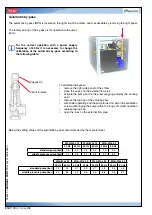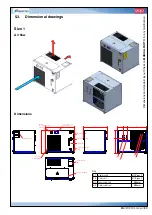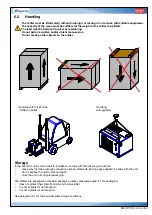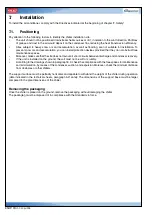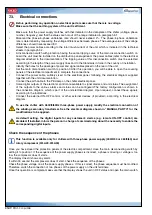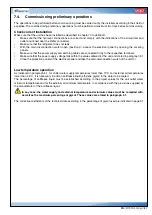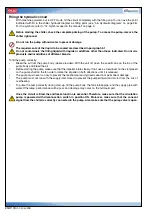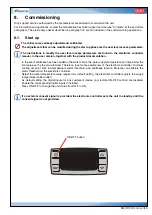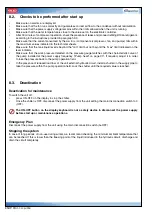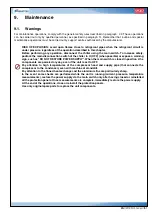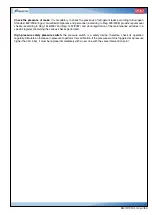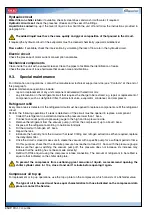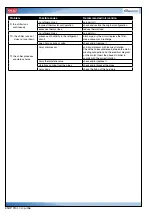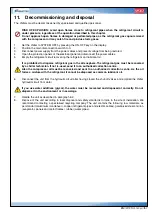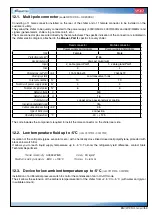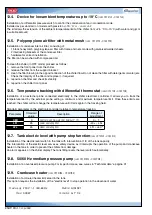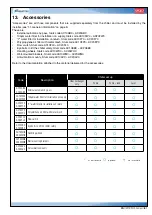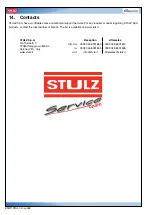
EN/
0915/WLA Compact
/52
9.2. Routine maintenance
Periodically check the chiller and its operation.
Routine maintenance must be performed according to the intervals indicated. Delays or omissions
make the warranty void and null, besides reducing the efficiency of the unit.
If, according to your experience, the unit requires more frequent maintenance interventions, these
must be performed according to the requirements.
Operation
Interval
Air circuit: cleang the whole module.
ONE
MONTH
Hydraulic circuit: clean the filter on the chiller water return
(if available)
Hydraulic circuit: check the level of the liquid to be cooled and top up if required.
Hydraulic circuit: check the presence of air and vent
Hydraulic circuit: check and repair any leaks and pipe insulation.
Electric components: identify anomalous consumptions.
Mechanical components: check the presence of anomalous noises and vibrations.
Air circuit: check the fixing, operation, and balance of the fan
FOUR
MONTHS
Hydraulic circuit: check the efficiency of the flow switch
(if available)
Hydraulic circuit: check the cleanliness of the water side evaporator
Electric circuit: make sure that the clamps on the electrical panel and compressor are tightened
correctly.
Electric circuit: check the cleanliness and integrity of the remote switch contacts.
Electric circuit: check the pressure switch connections.
Refrigerant circuit: check the presence of leaks
SIX
MONTHS
Refrigerant circuit: check the high pressure safety pressure switch
ONE YEAR
Air circuit
Heat exchanger:
heat exchangers can be exposed to external agents (mechanical and chemical stress) and to air
pollution. Dirt particles may deposit on the fins and reduce the heat transmission power, besides increasing air flow
resistance. As a consequence, the fan increases its current consumption.
The heat exchanger can be cleaned with pressurised air (maximum 2 bar) blown in the opposite direction compared
to the normal air flow.
Do not bend the fins during this operation not to reduce the efficiency of the heat exchanger and
increase the air side load losses.
Air filter (optional):
the polyurethane filter with metal mesh can be cleaned with pressurised air, once it has been
removed from its seat.
Fan:
make sure that the fan is secured to the chiller structure and make sure that the protection grid is also secured
correctly. Check the presence of anomalies on the consumed current, which may mean excessive obstruction of
the condenser or problems on the fan electric motor. Replace the fan in the event problems are detected on the fan
electric motor. The automatic control (optional) provides fan variable speed.
Refrigerator circuit
See paragraph “9.3. Special maintenance” to replace parts, recharge or perform operations on the
refrigerant circuit.
Lubricant oil:
the compressor contains an amount of oil, which must not be renewed under normal operating
conditions, and it lasts for the entire life span of the unit. However, as the oil has a hygroscopic reaction, it is
possible that it has absorbed air humidity, which comes into contact with the oil after leaks in the refrigerant circuit,
replacement of components, or faults of the dehydrator filter. The interaction between oil and water forms an acid that
may cause corrosive processes inside the compressor. In these situations, the lubricant oil must be fully replaced.

